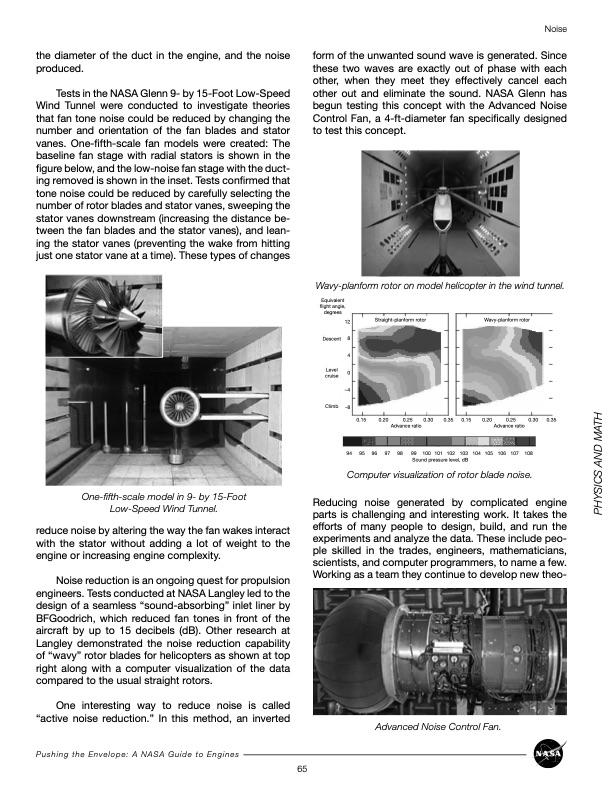
PDF Publication Title:
Text from PDF Page: 073
the diameter of the duct in the engine, and the noise produced. Tests in the NASA Glenn 9- by 15-Foot Low-Speed Wind Tunnel were conducted to investigate theories that fan tone noise could be reduced by changing the number and orientation of the fan blades and stator vanes. One-fifth-scale fan models were created: The baseline fan stage with radial stators is shown in the figure below, and the low-noise fan stage with the duct- ing removed is shown in the inset. Tests confirmed that tone noise could be reduced by carefully selecting the number of rotor blades and stator vanes, sweeping the stator vanes downstream (increasing the distance be- tween the fan blades and the stator vanes), and lean- ing the stator vanes (preventing the wake from hitting just one stator vane at a time). These types of changes One-fifth-scale model in 9- by 15-Foot Low-Speed Wind Tunnel. reduce noise by altering the way the fan wakes interact with the stator without adding a lot of weight to the engine or increasing engine complexity. Noise reduction is an ongoing quest for propulsion engineers. Tests conducted at NASA Langley led to the design of a seamless “sound-absorbing” inlet liner by BFGoodrich, which reduced fan tones in front of the aircraft by up to 15 decibels (dB). Other research at Langley demonstrated the noise reduction capability of “wavy” rotor blades for helicopters as shown at top right along with a computer visualization of the data compared to the usual straight rotors. One interesting way to reduce noise is called “active noise reduction.” In this method, an inverted form of the unwanted sound wave is generated. Since these two waves are exactly out of phase with each other, when they meet they effectively cancel each other out and eliminate the sound. NASA Glenn has begun testing this concept with the Advanced Noise Control Fan, a 4-ft-diameter fan specifically designed to test this concept. Wavy-planform rotor on model helicopter in the wind tunnel. Equivalent flight angle, degrees 12 Descent 8 4 Level 0 cruise –4 Climb –8 Straight-planform rotor 0.20 0.25 0.30 Advance ratio Wavy-planform rotor 0.20 0.25 0.30 0.35 Advance ratio Noise 0.15 0.35 0.15 Pushing the Envelope: A NASA Guide to Engines 94 95 96 97 98 99 100101102103104105106107 108 Sound pressure level, dB Computer visualization of rotor blade noise. Reducing noise generated by complicated engine parts is challenging and interesting work. It takes the efforts of many people to design, build, and run the experiments and analyze the data. These include peo- ple skilled in the trades, engineers, mathematicians, scientists, and computer programmers, to name a few. Working as a team they continue to develop new theo- Advanced Noise Control Fan. 65 PHYSICS AND MATHPDF Image | NASA Guide to Engines

PDF Search Title:
NASA Guide to EnginesOriginal File Name Searched:
nasa-guide-to-engines.pdfDIY PDF Search: Google It | Yahoo | Bing
NFT (Non Fungible Token): Buy our tech, design, development or system NFT and become part of our tech NFT network... More Info
IT XR Project Redstone NFT Available for Sale: NFT for high tech turbine design with one part 3D printed counter-rotating energy turbine. Be part of the future with this NFT. Can be bought and sold but only one design NFT exists. Royalties go to the developer (Infinity) to keep enhancing design and applications... More Info
Infinity Turbine IT XR Project Redstone Design: NFT for sale... NFT for high tech turbine design with one part 3D printed counter-rotating energy turbine. Includes all rights to this turbine design, including license for Fluid Handling Block I and II for the turbine assembly and housing. The NFT includes the blueprints (cad/cam), revenue streams, and all future development of the IT XR Project Redstone... More Info
Infinity Turbine ROT Radial Outflow Turbine 24 Design and Worldwide Rights: NFT for sale... NFT for the ROT 24 energy turbine. Be part of the future with this NFT. This design can be bought and sold but only one design NFT exists. You may manufacture the unit, or get the revenues from its sale from Infinity Turbine. Royalties go to the developer (Infinity) to keep enhancing design and applications... More Info
Infinity Supercritical CO2 10 Liter Extractor Design and Worldwide Rights: The Infinity Supercritical 10L CO2 extractor is for botanical oil extraction, which is rich in terpenes and can produce shelf ready full spectrum oil. With over 5 years of development, this industry leader mature extractor machine has been sold since 2015 and is part of many profitable businesses. The process can also be used for electrowinning, e-waste recycling, and lithium battery recycling, gold mining electronic wastes, precious metals. CO2 can also be used in a reverse fuel cell with nafion to make a gas-to-liquids fuel, such as methanol, ethanol and butanol or ethylene. Supercritical CO2 has also been used for treating nafion to make it more effective catalyst. This NFT is for the purchase of worldwide rights which includes the design. More Info
NFT (Non Fungible Token): Buy our tech, design, development or system NFT and become part of our tech NFT network... More Info
Infinity Turbine Products: Special for this month, any plans are $10,000 for complete Cad/Cam blueprints. License is for one build. Try before you buy a production license. May pay by Bitcoin or other Crypto. Products Page... More Info
| CONTACT TEL: 608-238-6001 Email: greg@infinityturbine.com | RSS | AMP |